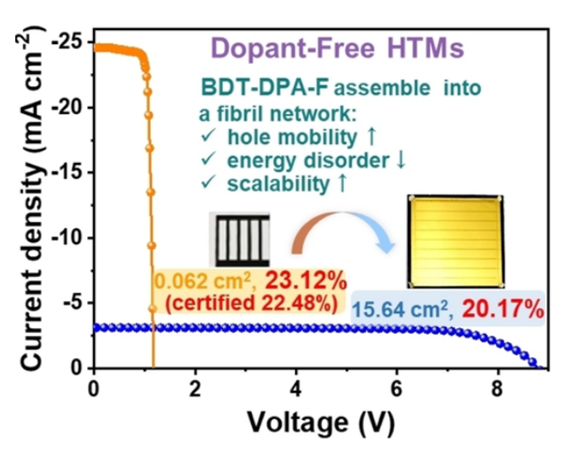Molecular Self-Assembly Regulated Dopant-Free Hole Transport Materials for Efficient and Stable n-i-p Perovskite Solar Cells and Scalable Modules
Qinrong Cheng 1 +, Haiyang Chen 1 +, Fu Yang 1 , Ziyuan Chen 1 , Weijie Chen 1 , Heyi Yang 1 , Yunxiu Shen 1 , Xue-Mei Ou 1 , Yeyong Wu 1 , Yaowen Li 1, 2,3 ,*(李耀文), Yongfang Li 1, 3, 4
1 Laboratory of Advanced Optoelectronic Materials, Suzhou Key Laboratory of Novel Semiconductor-optoelectronics Materials and Devices, College of Chemistry, Chemical Engineering and Materials Science, Soochow University, Suzhou, 215123, China.
2 State and Local Joint Engineering Laboratory for Novel Functional Polymeric Materials, Jiangsu Key Laboratory of Advanced Functional Polymer Design and Application, College of Chemistry, Chemical Engineering and Materials Science, Soochow University, Suzhou, 215123, China.
3 Jiangsu Key Laboratory of Advanced Negative Carbon Technologies, Soochow University, Suzhou, 215123, China.
4 Beijing National Laboratory for Molecular Sciences, CAS Key Laboratory of Organic Solids, Institute of Chemistry, Chinese Academy of Sciences, Beijing, 100190, China.
+ Theseauthorscontributedequallyto this work.
Angew. Chem.Int. Ed. 2022, e202210613
Dopant-free organic hole transport materials (HTMs) remain highly desirable for stable and efficient n-i-p perovskite solar cells (pero-SCs) but rarely succeed. Here, we propose a molecular assembly strategy to overcome the limited optoelectronic properties of organic HTMs by precisely designing a linear organic small molecule BDT-DPA-F from the atomic to the molecular levels. BDT-DPA-F can assemble into a fibril network, showing an obviously improved hole mobility and decreased energy disorder. The resultant pero-SCs showed a promising efficiency of 23.12 % (certified 22.48 %), which is the highest certified value of pero-SCs with dopant-free HTMs, to date. These devices also showed a weak-dependence of efficiency on size, enabling a state-of-the-art efficiency of 22.50 % for 1-cm(2) device and 20.17 % for 15.64-cm(2) module. For the first time, the pero-SCs based on dopant-free HTMs realized ultralong stabilities with T-80 lifetimes over 1200 h under operation or thermal aging at 85 degrees C.

链接://onlinelibrary.wiley.com/doi/10.1002/anie.202210613